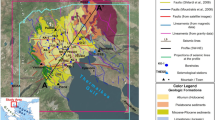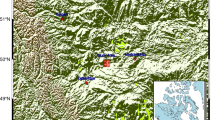Abstract
The optimum field development of area under exploration for hydrocarbons requires an integrated analysis of seismic and well log data. Fluid substitution is a process which provides a tool for fluid identification and quantification in a reservoir during the development phase. In the present study, an integrated approach of seismic, petrophysics, and Gassmann fluid substitution has been applied on Goru sands of Sanghar area, Pakistan, for optimum field development. The results of seismic indicate probable prospect zones of hydrocarbons in eastern and western part of the study area. These prospect zones have vertical closures of 20 to 50 ms and 20 to 30 ms at Goru sands and Chiltan levels, respectively. Four hydrocarbon-bearing zones (zones 1, 2, 3, and 4 with thicknesses of 28, 9, 24, and 8 m respectively) were identified on the basis of petrophysical interpretation of well log data at Goru sand level. Fluid substitution results at Goru sand level show maximum variation of P-wave velocity and density when hydrocarbon phase was substituted completely with water. This represents the maximum change in the acoustic impedance after complete extraction of hydrocarbon phase which can be modeled using synthetic seismograms.













Similar content being viewed by others
References
Ali A, Ahmad Z, Akhtar G (2005) Structural interpretation of seismic profiles integrated with reservoir characteristics of Qadirpur area. Pak J Hydrocarb Res 15:25–34
Al-Sadi HN (1980) Seismic exploration technique and processing, 1st edn. Birkhauser Verlag publications, Basel, 215
Asquith G, Gibson CR (1982) Basic well log analysis for geologists. AAPG memo. AAPG, Tulsa, 216
Asquith GB, Krygowski D, Gibson, CR (2004) Basic well log analysis. American Association of Petroleum Geologist
Avseth P, Mukerji T, Mavko G (2005) Quantitative seismic interpretation: applying rock physics tools to reduce interpretation risk. Cambridge University Press, Cambridge
Badley M (1985) Practical seismic interpretation. IHRDC Publishers, Boston, 266
Banks CJ, Warburton J (1986) Passive roof duplex geometry in the frontal structure of Kirthar and Sulaiman Mountain Belt, Pakistan. J Struct Geol 8:229–237
Batzle ML, Wang Z (1992) Seismic properties of pore fluids. Geophysics 64:1396–1408
Berryman J, Berge P, Bonner B (2002) Estimating rock porosity and fluid saturation using only seismic velocities. Geophysics 67(2):391–404
Castagna JP, Batzle ML, Eastwood RL (1985) Relationship between compressional-wave and shear-wave velocities in clastic silicates. Geophysics 50(4):571–581
Duffy J, Mindlin RD (1957) Stress–strain relations and vibrations of a granular medium. J Appl Mech 24:585–593
Fatmi AN (1973) Lithostratigraphic units of Kohat –Potwar Provence, Indus Basin Pakistan. Pak Geol Surv Mem 10:80
Gassmann F (1951)Über die elastizitätporösermedien: Vierteljahrsschrift der NaturforschendenGesellschaft in Zurich 96:1–23
Han DH, Batzle ML (2004) Gassmann’s equation and fluid-saturation effects on seismic velocities. Geophysics 69(2):398–405
Hill R (1952) The elastic behavior of a crystalline aggregate. Proc Phys Soc Lond Ser A 65:349–354
Iqbal MWA, Shah SMI (1980) A guide to the stratigraphy of Pakistan, geological survey of Pakistan records. Geol Surv Pak Quetta 53:34
Kadri IB (1995) Petroleum geology of Pakistan. Pakistan Petroleum Limited, Karachi
Kadri IB (1993) Cretaceous source rocks in Pakistan. AAPG/ SVG, International Conference and Exhibition, Venezuela
Kingston DR, Dishroon CP, Williams PA (1983) Global basin classification system. AAPG Bull 67(12):2175–2193
Krief M et al. (1990) A petrophysical interpretation using the velocities of P and S waves (full-waveform sonic). Log Analyst, 31, November, pp 355–369
Kumar D (2006) Tutorial on Gassmann fluid substitution: formulation, algorithm and Matlab code: Geohorizons
Lines LR, Newrick RT (2004) Fundamentals of geophysical interpretation. Society of Exploration Geophysicists
Mavko G, Mukerji T, Dvorkin J (2009) The rock physics handbook: tools for seismic analysis in porous media: Stanford Univ. Press
Nguyen PKT, Nam MJ (2011) A review on methods for constructing rock physics model of saturated reservoir rock for time-lapse seismic. Geosyst Eng 14(2):95–107
Quadri VUN, Shuaib SM (1986) Hydrocarbon prospects of southern Indus basin, Pakistan. Am. Assoc. Pet. Geol., Bull, United States.70, no. 6
Russell BR, Hedlin K, Hilterman FJ, Lines LR (2003) Fluid-property discrimination with AVO: a Biot-Gassmann perspective. Geophysics 68:29–39
Schlumberger (1972) Log interpretation manual/principles. Vol I. Schlumberger Well Services, Inc, Housten
Schlumberger (1991) Log interpretation principles/applications. Schlumberger Educational Services
Simm R (2007) Practical Gassmann fluid substitution in sand/shale sequences. First Break 25(12):61–68
Skelt C (2004) Fluid substitution in laminated sands. Lead Edge 23(5):485–493
Smith TM, Sondergeld CH, Rai CS (2003) Gassmann fluid substitutions: a tutorial. Geophysics 68:430–440
Telford WM, Sheriff RE (1990) Applied geophysics (vol. 1): Cambridge University Press
Tiab D, Donaldson EC (2011) Petrophysics: theory and practice of measuring reservoir rock and fluid transport properties. Gulf professional publishing
Wood AW (1955) A textbook of sound. The Macmillan Co., New York
Zhu X, McMechan GA (1990) Direct estimation of the bulk modulus of the frame in fluid saturated elastic medium by Biot theory: 60th Ann. Internat. Mtg., Soc. Expl. Geophys., Expanded Abstract 787–790
Zinszner B, Pellerin FM (2007) A geoscientist’s guide to petrophysics. Editions Ophrys
Acknowledgments
Prof. Dr. Gulraiz Akhter would like to thank the Directorate General of Petroleum Concessions (DGPC), Pakistan, for allowing the use of seismic and well log data for research and publication purposes and the Department of Earth Sciences, Quaid-i-Azam University, Islamabad, Pakistan, for providing the basic requirements to complete this work.
Author information
Authors and Affiliations
Corresponding author
Rights and permissions
About this article
Cite this article
Akhter, G., Ahmed, Z., Ishaq, A. et al. Integrated interpretation with Gassmann fluid substitution for optimum field development of Sanghar area, Pakistan: a case study. Arab J Geosci 8, 7467–7479 (2015). https://doi.org/10.1007/s12517-014-1664-8
Received:
Accepted:
Published:
Issue Date:
DOI: https://doi.org/10.1007/s12517-014-1664-8




